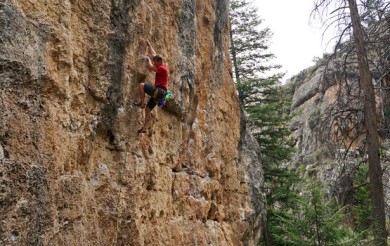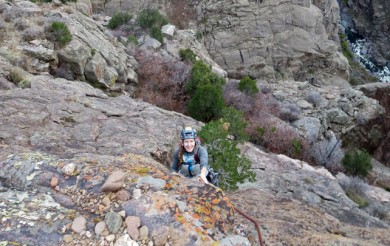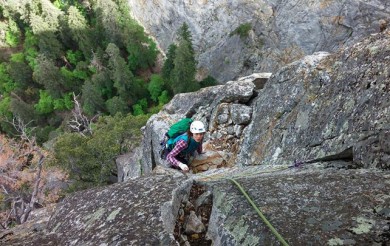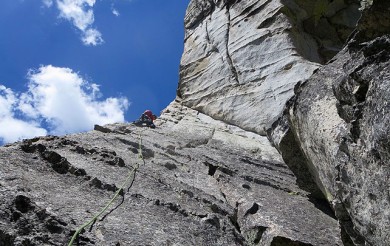Injury Prevention
A quick perusal of the message boards at mountainproject.com, rockclimbing.com and climbinginjuries.com shows there are usually a lot of folks trying to figure out how to get through an injury. We’ve already covered what to do if/when you get hurt, and how to come back the right way, so this month we’re looking at ways to maintain your health once you get it back and how to prevent injuries from happening in the first place.
If you got hurt, there is a reason, and you’ll likely want to avoid that scenario in the future. Whether it was from over training, grabbing a tweaky hold, or a muscle imbalance, there is much to learn and apply to your climbing moving forward. Here’s my list of the top ways to maintain your health once you are fully recovered and prevent injury in the first place.
Strengthen Weak/Opposing Muscles
Muscle imbalances can lead to all kinds of fun problems, like shoulder tendinitis, impingement, etc. That hunched over look we all get is good for gorillas, but not so much for human beings. Like everything else in life, balance is key. A good training program should include at least two days a week of antagonistic muscle training, strengthening the muscles that work opposite climbing ones. Things like push ups, reverse wrist curls and various shoulder exercises are crucial to maintaining full body health. Also, if you know a specific area is weak, be sure to give it some extra attention.
Stretch!
We all know this is good for us, but how many do it on a regular basis? I know I need to start doing yoga, since I’m about as bendy as a board, but still I can’t seem to get into the groove. Flexible muscles are healthy muscles, and much less likely to tear. Taking just 20 minutes a day to stretch can make a big difference over time.
Stay Away From Tweaky Holds/Moves
This should seem obvious, but often we get lost in the heat of the moment on a hard pitch, and our better judgment goes by the wayside. If you’ve had problems with a particular move in the past, it’s best not to rush right back in and try the same thing again. If you know shallow pockets give your fingers problems, stay away from them, if your shoulders don’t like gastons, you get the idea. There are enough awesome climbs in the world that backing off one in order to stay healthy shouldn’t be a big deal whatsoever.
Get Plenty of Rest
This one is a little less obvious, but our body recovers the most while we are sleeping. If you aren’t getting enough sleep, you aren’t recovering fully, and this can lead to a build up of stresses on your body that may ultimately result in injury. 7-8 hours per night is the standard, your body might need more, but less is unlikely. There is a lot of incredible research on sleep out there, but the main point is all the same: get more sleep, have a happier life.
Stay Hydrated
So drinking that big cup of coffee before heading out to the crag isn’t good for me? Well, coffee is a diuretic, so the short answer is no. Keeping yourself well hydrated throughout the day keeps all your muscles and tendons working properly, and again, less prone to injury.
Warm Up Properly
Maybe the most common mistake I see a lot of climbers make is how they warm up. You can go find the studies, but basically it takes about 4 routes or so for you to warm up. So whatever your project is for the day, start well below that and gradually increase the difficulties until you are warm and ready to try hard.
Listen to Your Body
This takes time to get used to, but once you are in tune with your body, you’ll know when you need a little more rest, or when you can push it a little harder. There are often signs of soreness, weakness, fatigue, a feeling of being off. Don’t ignore these things. An extra day off is much better than an extra month off.
Climb Consistently
This is the big one. If you climb consistently, you are keeping your climbing muscles and tendons strong for the specific tasks you need them for. If you don’t, you open yourself to injury because your body wont be accustomed to those stresses. The problem with injury is that it can suck you into a cycle of to much time off, followed by more injury, etc. Coming back slow and smart seems to be the key to breaking this cycle.
Even if you follow all of this to the letter, you will still likely get injured at some point. There are a rare few out there who seem blessed with genetics that allow them to do just about anything they want to their bodies, but for most of us this is not the case. However, doing as much of this is possible will certainly increase your chances of staying healthy, and ultimately climbing harder.
3 Responses to Injury Prevention
Bulldog Creek Dog Walk (IV WI 4+)
Hayden Carpenter and Tom Bohanon recently repeated an obscure ice climb on the south side of Mt Sopris. Given a brief mention in Jack Robert’s ice guide, Bulldog Creek Walk is described as being 100 meters of WI 4. What they found was seven pitches of ice in a remote setting that makes for one […]
Connect with Us















As far as I’ve read on the internets, the idea of coffee being a diuretic and increasing dehydration is still hotly debated. In this Wikipedia article, they state flat out, with four different sources, that coffee is not a diuretic and contains no less hydrating powers than pure water: http://en.wikipedia.org/wiki/Health_effects_of_coffee#Laxative.2Fdiuretic
A morning milky coffee is one of my favorite pre-climb rituals, and science will back me up! 🙂
Actually, caffeine seems to have little or no diuretic effect in normal doses:
http://www.nytimes.com/2008/03/04/health/nutrition/04real.html
Well, I stand corrected. Still makes me feel dehydrated though, and I definitely pee a lot more after I drink it. Maybe I make it too strong?